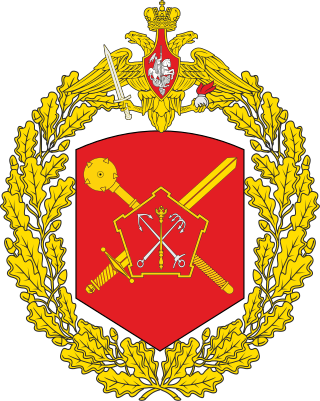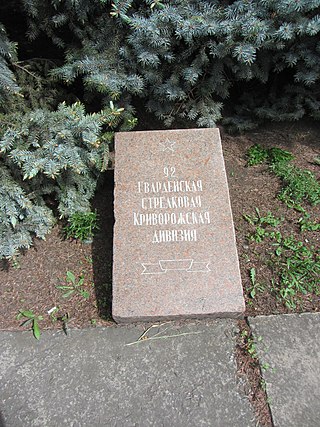Related Research Articles

The 8th Guards Order of Lenin Combined Arms Army is an army of the Russian Ground Forces, headquartered in Novocherkassk, Rostov Oblast, within Russia′s Southern Military District, that was reinstated in 2017 as a successor to the 8th Guards Army of the Soviet Union's Red Army, which was formed during World War II and was disbanded in 1998 after being downsized into a corps.

The 1st Ukrainian Front, previously the Voronezh Front, was a major formation of the Soviet Army during World War II, being equivalent to a Western army group.

The 6th Combined Arms Army is a field army of the Red Army and the Soviet Army that was active with the Russian Ground Forces until 1998, and has been active since 2010 as the 6th Combined Arms Army.
The 52nd Rifle Division was an infantry division of the Red Army during the Russian Civil War, the interwar period, World War II, and the Cold War, formed once during the Russian Civil War and three times during the existence of the Soviet Union.
The 59th Guards Kramatorsk Order of Red Banner, Order of Suvorov, Order of Bogdan Khmelnitsky Motor-Rifle Division of the Soviet Union's Red Army was initially formed near Krasnodar in March 1942 as the 197th Rifle Division. On the division's formation Colonel M. I. Zaporozhchenko took command, who stayed with the division until February 1943. Its second commander was Major-General G. P. Karamyshev from February 1943 up to the end of the war.
The 3rd Shock Army was a field army of the Red Army formed during the Second World War. The "Shock" armies were created with the specific structure to engage and destroy significant enemy forces, and were reinforced with more armoured and artillery assets than other combined arms armies. Where necessary the Shock armies were reinforced with mechanised, tank, and cavalry units. During the Second World War, some Shock armies included armoured trains and air–sled equipped units.

The 20th Guards Motor Rifle Division is a formation of the Russian Ground Forces, originally formed within the Soviet Red Army as the 3rd Mechanised Corps. The division was reformed in 2021 from the former 20th Guards Motor Rifle Brigade.

The 39th Guards Motor Rifle Division of the Soviet Ground Forces was a mechanised infantry division active from 1965 to 1992. It was originally formed as the 39th Guards Rifle Division of the Workers and Peasant's Red Army. It was formed during the German-Soviet War as part of the 62nd Army and assigned to the defense of Stalingrad, officially arriving in the theater in August 1942. In September the division fought through German forces which were attempting to encircle the city, and was assigned to defend the 'Volga Corridor,' the last supply line remaining for Soviet units in the city.
The 12th Guards Uman Orders of Lenin Red Banner and Suvorov Tank Division was a tank division of the Soviet Ground Forces. It drew its history from the World War II 16th Tank Corps. It was redesignated successively as 12th Guards Tank Corps (1943) and 12th Guards Tank Division (1946).
The 266th Rifle Division was a rifle division of the Soviet Red Army during World War II. The 266th was formed three times during the war.

The 92nd Training Centre was a formation of the Ukrainian Ground Forces, that drew most of its history from the 92nd Guards Rifle Division, that became the 92nd Guards Training Motor Rifle Division in 1965.
The 40th Guards Rifle Division was one of a series of ten Guards rifle divisions of the Red Army formed from airborne troops in the spring and summer of 1942 in preparation for, or in response to, the German summer offensive. It fought in the Stalingrad area during that battle, eventually in the operations that encircled German 6th Army, and then continued to serve in the several campaigns in the south sector of the front, helping to liberate Ukraine and the Balkans, and ending the war at Vienna.
The 7th Guards Cavalry Corps of the Soviet Union's Red Army was a cavalry corps active during the Second World War. It was formed from the 8th Cavalry Corps in February 1943.

The 5th Shock Army was a Red Army field army of World War II. The army was formed on 9 December 1942 by redesignating the 10th Reserve Army. The army was formed two times prior to this with neither formation lasting more than a month before being redesignated.
The 32nd Guards Tank Division was a tank formation of the Soviet Army/Soviet Ground Forces. Its predecessor, the 9th Guards Airborne Division, was a Red Army Airborne division of World War II. On 19 June 1945, it became the 116th Guards Rifle Division. In 1946, it became the 14th Guards Mechanized Division. In 1957, it became the 14th Guards Motorized Rifle Division. In 1982, it became the 32nd Guards Tank Division, which was disbanded in June 1989.
The 416th Rifle Division was formed for the first time as a standard Red Army rifle division late in 1941, after the Soviet winter counteroffensive had begun, but was soon re-designated. A second formation began in March 1942, this time as an Azerbaijani National Division and was completed in July, after which it remained serving in the southern sectors of the Soviet-German front until the autumn of 1944, when it was redeployed to Poland in anticipation of the final offensives into the German heartland. The 416th compiled a record of service comparable to any majority-Russian unit, and saw postwar service in the Group of Soviet Forces in Germany.
The 1st Guards Tank Division was a tank division of the Soviet Army from 1945 to 1947, stationed in Neuruppin. It was formed in the spring of 1942 as the 26th Tank Corps. The corps fought in Operation Uranus and became the 1st Guards Tank Corps, being redesignated as a reward for its actions in December 1942. It fought in Operation Gallop, the Third Battle of Kharkov, Operation Kutuzov, Operation Bagration, the East Prussian Offensive, the East Pomeranian Offensive and the Berlin Offensive. During the East Prussian Offensive, the division captured Mława, Działdowo and Płońsk and was awarded the Order of Lenin for its actions. The division had been awarded the honorific "Don" for its actions in Operation Gallop. It also was awarded the Order of the Red Banner and the Order of Suvorov 2nd class.
The 14th Guards Rifle Division was reformed as an elite infantry division of the Red Army in January, 1942, based on the 1st formation of the 96th Rifle Division, which was officially a mountain unit at the time, and served in that role until after the end of the Great Patriotic War. It was on Southern Front when it was redesignated and was soon assigned to the 57th Army. It was encircled during the May German counterattack in the Second Battle of Kharkov. Its first commander was made a prisoner of war, later dying in German captivity. A cadre of the division managed to escape and was sent to the Reserve of the Supreme High Command for rebuilding. In July it joined the 63rd Army and took part in the attacks against the Italian 8th Army that created the bridgehead south of the Don River near Serafimovich during August. In October, now in the 21st Army of Don Front, it was active in two probing attacks against the Romanian forces now containing the bridgehead which inflicted severe casualties in advance of the Soviet winter counteroffensive. At the start of that offensive the division was in 5th Tank Army, but was soon transferred to 1st Guards Army and then to the 3rd Guards Army when that was formed. It was under this Army as it advanced into the Donbas in late winter before returning to 57th Army during most of 1943, fighting through east Ukraine and across the lower Dniepr by the end of the year. After being briefly assigned to 53rd Army in December it was moved to 5th Guards Army in February, 1944 where it remained for the duration, mostly in the 33rd Guards Rifle Corps. It saw action in the Uman–Botoșani Offensive and won its first decoration, the Order of the Red Banner, as it advanced, before being involved in the frustrating battles along the Dniestr River on the Romanian border. In late spring, 1944 the division was redeployed north becoming part of 1st Ukrainian Front and taking part in the Lvov–Sandomierz Offensive into Poland. The 14th Guards made a spectacular advance across Poland during the Vistula-Oder Offensive and was awarded the Order of Lenin for its part in the liberation of Sandomierz. On January 22, 1945, its commander suffered mortal wounds in the fighting for a bridgehead over the Oder River. In the drive on Berlin in April the division and its regiments won further honors and decorations but despite these distinctions it was disbanded in August, 1946.
The 118th Rifle Division was thrice formed as an infantry division of the Red Army, first as part of the prewar buildup of forces. The first formation was based on the shtat of September 13, 1939. It was based at Kostroma through its early existence. After the German invasion in June 1941 it was rushed to the front as part of the 41st Rifle Corps and arrived at the Pskov Fortified Area between July 2–4. Under pressure from the 4th Panzer Group the division commander, Maj. Gen. Nikolai Mikhailovich Glovatsky, requested permission on July 8 to retreat east across the Velikaya River. There is some question if he received written orders and in any case the retreat fell into chaos due to a prematurely-blown bridge. Glovatskii was arrested on July 19, sentenced to death a week later and shot on August 3. The battered division had by then moved north to Gdov and came under command of 8th Army but could not be rebuilt due to a lack of replacements and on September 27 it was disbanded.
The 110th Guards Rifle Division was formed as an elite infantry division of the Red Army from July into September 1943, based on the 5th Guards Rifle Brigade and the 7th Guards Rifle Brigade and was the third of a small series of Guards divisions formed on a similar basis. It would follow a very similar combat path to the 108th and 109th Guards Rifle Divisions and would serve well into the postwar era.
References
- ↑ Holm, Michael. "57th Guards Motorised Rifle Division". www.ww2.dk. Retrieved 2016-03-03.